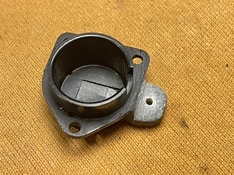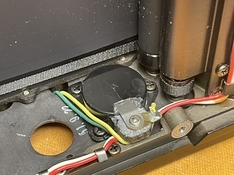fdonadio
Member
After taking my Nikon F2 to a technician in Berlin — one with a hugely positive reputation, by the way — he told me he couldn't fix it, as the shutter speed was "electronically controlled". I didn't want to argue with him, as to avoid friction. I think he confused it with an F3... He was a little bit overwhelmed by the ringing phone and customers' cameras waiting for him, besides having to talk to me in German (I'm still a lousy speaker). Well, I left three Seiko shutters to be CLA'd and took the Nikon home.
The problem, as he himself diagnosed, was that the slow speeds were failing. They would fire as fast as 1/60 or so, to my ear. After reading https://www.photrio.com/forum/threads/nikon-f2-shutter-speed-problems.173357/ , I've decided to take the plunge and try to fix it myself. I am not sure if the camera had never been serviced before, because several screws had something like Loctite on them. I used q-tips with acetone, a lot of patience and care, and was finally able to remove all necessary screws without any harm to them — except for one, that got the philips head a little bit damaged, but is still serving its purpose.
After taking the bottom cover plate and the mirror box out, I saw the slow speed escapement on the bottom of the camera body. Following mikeno62's video on YouTube made it very easy. My F2 seems to be a lot newer than the one he works on in the video. Mine has pretty much all screws with philips heads, instead of flat blade. I carefully took the mechanism out and it was completely jammed! Nothing moved at all. But there was absolutely no signs of gunk, everything looked squeaky clean. Anyway, I dipped the whole mechanism in naphtha and gently cleaned it with the help of a brush. The naphtha stayed mostly the same color. As I was taking it off the bath, it fell from between my tweezers on the table and a small piece of plastic came out of it. Now I got scared! Did I break something?
Looking at the mechanism, I could see no plastic at all. It's totally made of metal parts... Then, to my surprise, I exercised the mechanism and it worked as it should! So, I concluded the plastic bit was a foreign object and felt relieved. But where did that come from? I looked all over the camera, using loupes and lights, trying to find a broken piece of plastic. Nothing. At some point, I decided to move some wires out of the way and one more bit fell out from the battery compartment. Voila! The small "tab" in the battery compartment, where the positive contact is screwed onto, had broken, just like in https://www.photrio.com/forum/threads/nikon-f2-battery-compartment-fun.197117/ . A small piece of it got into the slow speed escapement and jammed it! A quick Google search showed I wouldn't find a replacement so easily, so I decided to fix the part I had. Using superglue, sodium bicarbonate (baking powder) and a nail file, I've rebuilt the tab:


I waited for the low speed escapement to dry, then lubed it using Mobius' Synta-Frigo-Lub watch oil, exercised it for a while and cleaned any excess lube with a q-tip. Cleaned the battery compartment and applied a thin coat of clear matte nail polish to the repaired area, to avoid dirt getting into other places. Mounted everything back into their places, routed the wires correctly and carefully screwed the battery contact:


Reassembled the camera after testing it with the mirror box back into place. Works perfectly!
Now I just need to glue the leatherette back, following the recommendations from https://www.photrio.com/forum/threads/adhesive-for-camera-leather.193877/ .
Thanks, Photrio members!!!
The problem, as he himself diagnosed, was that the slow speeds were failing. They would fire as fast as 1/60 or so, to my ear. After reading https://www.photrio.com/forum/threads/nikon-f2-shutter-speed-problems.173357/ , I've decided to take the plunge and try to fix it myself. I am not sure if the camera had never been serviced before, because several screws had something like Loctite on them. I used q-tips with acetone, a lot of patience and care, and was finally able to remove all necessary screws without any harm to them — except for one, that got the philips head a little bit damaged, but is still serving its purpose.
After taking the bottom cover plate and the mirror box out, I saw the slow speed escapement on the bottom of the camera body. Following mikeno62's video on YouTube made it very easy. My F2 seems to be a lot newer than the one he works on in the video. Mine has pretty much all screws with philips heads, instead of flat blade. I carefully took the mechanism out and it was completely jammed! Nothing moved at all. But there was absolutely no signs of gunk, everything looked squeaky clean. Anyway, I dipped the whole mechanism in naphtha and gently cleaned it with the help of a brush. The naphtha stayed mostly the same color. As I was taking it off the bath, it fell from between my tweezers on the table and a small piece of plastic came out of it. Now I got scared! Did I break something?
Looking at the mechanism, I could see no plastic at all. It's totally made of metal parts... Then, to my surprise, I exercised the mechanism and it worked as it should! So, I concluded the plastic bit was a foreign object and felt relieved. But where did that come from? I looked all over the camera, using loupes and lights, trying to find a broken piece of plastic. Nothing. At some point, I decided to move some wires out of the way and one more bit fell out from the battery compartment. Voila! The small "tab" in the battery compartment, where the positive contact is screwed onto, had broken, just like in https://www.photrio.com/forum/threads/nikon-f2-battery-compartment-fun.197117/ . A small piece of it got into the slow speed escapement and jammed it! A quick Google search showed I wouldn't find a replacement so easily, so I decided to fix the part I had. Using superglue, sodium bicarbonate (baking powder) and a nail file, I've rebuilt the tab:


I waited for the low speed escapement to dry, then lubed it using Mobius' Synta-Frigo-Lub watch oil, exercised it for a while and cleaned any excess lube with a q-tip. Cleaned the battery compartment and applied a thin coat of clear matte nail polish to the repaired area, to avoid dirt getting into other places. Mounted everything back into their places, routed the wires correctly and carefully screwed the battery contact:


Reassembled the camera after testing it with the mirror box back into place. Works perfectly!
Now I just need to glue the leatherette back, following the recommendations from https://www.photrio.com/forum/threads/adhesive-for-camera-leather.193877/ .
Thanks, Photrio members!!!


